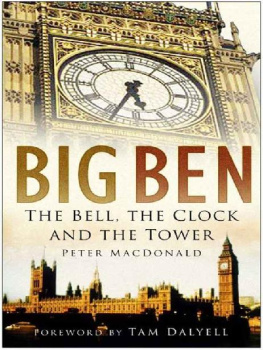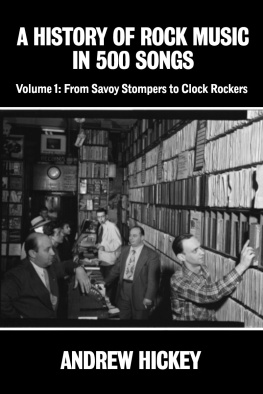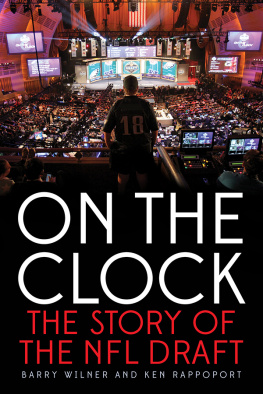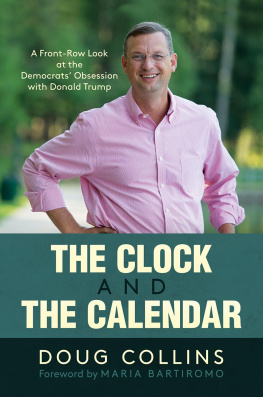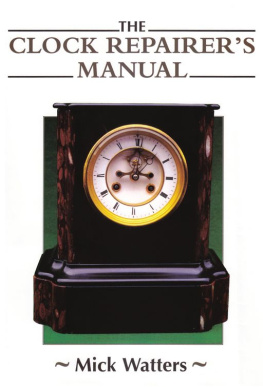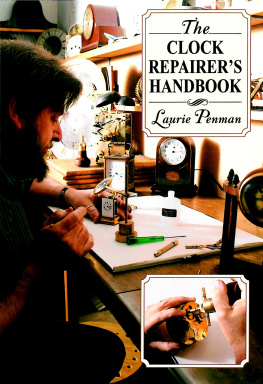
BIG BEN
BIG BEN
THE BELL, THE CLOCK
AND THE TOWER
P ETER M ACDONALD
F OREWORD BY T AM D ALYELL

This book was first published in 2004 by
Sutton Publishing Limited
This paperback edition first published in 2005
The History Press
The Mill, Brimscombe Port
Stroud, Gloucestershire, G l5 2 QG
www.thehistorypress.co.uk
This ebook edition first published in 2013
All rights reserved
Peter Macdonald, 2004, 2013
The right of Peter Macdonald to be identified as the Author of this
work
has been asserted in accordance with the Copyrights, Designs and
Patents Act 1988.
This ebook is copyright material and must not be copied, reproduced, transferred, distributed, leased, licensed or publicly performed or used in any way except as specifically permitted in writing by the publishers, as allowed under the terms and conditions under which it was purchased or as strictly permitted by applicable copyright law. Any unauthorised distribution or use of this text may be a direct infringement of the authors and publishers rights, and those responsible may be liable in law accordingly.
EPUB ISBN 978 0 7524 9549 1
Original typesetting by The History Press
Contents
Foreword
In my forty-two years as a Member of Parliament, I have looked up to Big Ben thousands of times from New Palace Yard. However, between 1962 and 1976 I fear I took the chimes for granted. That is until Big Ben went silent. Peter Macdonald puts it with characteristic elegance:
The Great Clock had now been operating for some months with the movement supported rather precariously on the two hydraulic jacks and with no chime; it could not be allowed to continue in this fashion. Of course, although silent it is still a beautiful clock, but with no chime it lacked its crowning glory, rather like a blackbird with no song or a rose without a scent. Somehow it had to be restored.
Proudly standing at the corner of the Palace of Westminster, the world-famous icon Big Ben is familiar to many and perhaps almost too familiar to those, like myself, who have passed it daily and whose days are regulated by its chimes. In his new book, Peter Macdonald has caused me to stop and think about this great monument. He reveals the bitter rivalry, scientific innovation and engineering problems that beset Big Ben during its conception in the 1830s. The struggle for accuracy unprecedented in such a large outdoor clock, today still one of the largest in the world remains unsurpassed.
In the most momentous events of the twentieth century Big Ben played its part. I well remember, as a young boy, its victory peal signalling the end of the Second World War. It has also had a vital role in more light-hearted occasions. Who does not remember the celebrations for the Queens Golden Jubilee? And how strange it would be if the New Year was not rung in by its great bell.
By delving into the history behind Big Ben, Peter Macdonald has shed new light on this famous but perhaps taken-for-granted symbol. I, for one, will not now hear the chimes nor see the impressive tower without a greater sense of the fascinating history and magnificent achievement that is Big Ben.

Tam Dalyell, 2004
Acknowledgements
The help of the following during my research is gratefully acknowledged: British Library Newspaper Library for press reports and programme details from Radio Times; Ursula Carlyle, Curator and Archivist of the Mercers Company for the history of the Royal Exchange; Robert Crayford, Archivist at St Pauls Cathedral for the history of the clock and bells; John Davis, Senior Archive Assistant at the BBC Written Archives Centre for broadcasting schedules; Guildhall Library for the history of E.J. Dent & Company; House of Lords Record Office for the building of the Great Clock and tower and details of the temporary chimes; Alan Hughes and Mandy Davis of the Whitechapel Bell Foundry for the inscription on Big Ben, its statistics and those of the quarter bells and Britains heaviest bells; Professor Frank King, University Bellringer and Keeper of the University Clock for the history of Great St Marys Church, the clock and bells; Matthew Read, Assistant Curator of Horology at the Royal Observatory, Greenwich for the history of the Greenwich Time Ball and the telegraph link to Westminster; Brian Tipper, Horological Engineer at the Palace of Westminster for details of regulating and maintaining the Great Clock.
Introduction
Big Ben is a character, a personality, the very heart of London, and the clock tower at the Houses of Parliament has become the symbol of Britain, known and loved around the world. It is the nations clock, instantly recognisable, brought into British homes every day to give the time signal on BBC Radio 4, its strokes used to introduce ITVs News at Ten, and seen and heard frequently on other news and current affairs programmes. It has always been popular with authors and film makers and the famous scene in the screen adaptation of John Buchans novel The Thirty-Nine Steps, together with appearances in many other films and documentaries, has done much to establish the clock as a cultural icon. Nowadays, almost every guidebook to London features a picture of Big Ben on the cover it represents the capital, along with the black taxi and the Routemaster bus.
But Big Ben is more than a clock as part of Britains heritage it has long been established as the nations timepiece, its chimes heralding almost every broadcast of national importance, announcing both the nations joy and the nations grief. Yet despite its Gothic appearance, the clock tower, and indeed the present Houses of Parliament, came into existence only after fire destroyed the ancient Palace of Westminster in the 1830s and plans for the new Houses of Parliament included a fine clock on the northern tower. It was to be a king among clocks, towering over Westminster and striking the first blow of each hour to within a second of the time, an accuracy which most leading members of the clockmaking fraternity believed to be unattainable on such a large turret clock where four sets of very heavy hands are subject to the mercy of all weathers. In an effort to overcome this seeming technical impossibility the Worshipful Company of Clockmakers even appealed to Parliament for less severe specifications. But this request was refused and after much uncertainty and delay the clock was eventually designed, not by a well-known and much respected professional clockmaker, but by the most gifted and resourceful of amateurs whose determination and inventive genius were to be almost entirely responsible for the magnificent clocks completion.
In the mid-nineteenth century, great strides were being made in the fields of science and engineering among them the pioneering of photography, the discovery of Neptune in 1846 and the development of the railway network throughout the United Kingdom. For the science of horology there could be no greater challenge than the building of the largest and most accurate public timepiece in the world; and it is a lasting tribute to the Victorian engineers and craftsmen not only that such accurate running was achieved but also that it has been maintained from the very first tick in 1859 right up to the present day. As society developed, there was increasing need for such accuracy; and as the clock may be heard from within the Commons, one of its original purposes was the timing of parliamentary debates.
Next page
